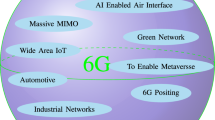Abstract
The next-generation wireless personal communications systems are expected to support a wide range of high-quality services that require high data rates. Communicating at high transmission rates over the harsh wireless environment, however, creates many difficult and challenging problems. In this paper, we describe a technique for the high-speed transmission of data in wireless personal communications which we denote as multicode modulation. In this technique, the high-rate bit transmitted data is serial to parallel converted into low-rate bit streams in a similar fashion to multicarrier or multitone modulation. However, in contrast to the multicarrier method, here we propose to modulate each low-rate bit stream using direct-sequence spread-spectrum on a single carrier. It is demonstrated that by selecting the processing gain properly the total required bandwidth will be of the same order as the original high-rate data stream; thereby, gaining the inherent benefit of multipath rejection without expanding the bandwidth of the original high-rate stream. To demonstrate the potential and merits of the proposed method as an alternative technique for high-speed transmission for wireless personal communications, various simulation results over a multipath Rayleigh fading link are presented.
Similar content being viewed by others
References
J. E.Padgett, C. G.Günther, and T.Hattori, “Overview of wireless personal communications” IEEE Commun. Mag., Vol. 33, No. 1, pp. 28–41, 1995.
J. C.-I.Chuang, “The effects of time delay spread on portable radio communications channels with digital modulation”, IEEE Journ. on Selected Areas in Communications, Vol. JSAC-5, No. 5, pp. 879–889, 1987.
J. G.Proakis, “Adaptive equalization for TDMA digital mobile radio,” IEEE Trans. Veh. Technol., Vol. VT-40, No. 2, pp. 333–341, 1991.
R. L.Pickholtz, L. B.Milstein, D. L.Schilling, “Spread Spectrum for Mobile Communications,” IEEE Trans. Veh. Technol., Vol. 40, No. 2, pp 313–322, 1991.
K. BenLetaief, “The performance of optical fiber direct-sequence spread-spectrum multiple-access communications systems,” IEEE Trans. Commun., Vol. COM-43, No. 11, pp. 2662–2666, 1995.
D. E.Borth and M. B.Pursley, “Analysis of direct-sequence spread-spectrum multiple access communication over Rician fading channels,” IEEE Trans. Commun., Vol. COM-27, pp. 1566–1577, 1979.
G. L.Turin, “The effects of multipath and fading on the performance of direct-sequence CDMA systems,” IEEE Trans. Veh. Technol., Vol. VT-33, pp. 213–219, 1984.
J. G.Proakis, Digital Communications, 2nd ed., McGraw-Hill, New York, 1989.
L. J.CiminiJr., “Analysis and simulation of a digital mobile-channel using orthogonal frequency division multiplexing,”, IEEE Trans. Commun., Vol. COM-33, No. 7, pp. 665–675, 1985.
I.Kalet, “The multitone channel,” IEEE Trans. Commun., Vol. COM-37, No. 2, pp. 119–124, 1989.
J. A. C. Bingham, “Multicarrier modulation for data transmission: An idea whose time has come,” IEEE Commun. Mag., pp. 5–14, 1990.
R. G.Gallager, Information Theory and Reliable Communications, Wiley, New York, 1968.
P.Balaban and J.Salz, “Optimum diversity combining and equalization in digital data transmission with applications to cellular mobile ratio—Part I: Theoretical considerations,”, IEEE Trans. Commun., Vol. COM-40, No. 5, pp. 885–894, 1992.
A.Zigic, “Adaptive equalization for high-speed indoor wireless data communication,” International Journal on Wireless Personal Communications, Vol. 1, pp. 229–251, 1995.
T.Wilkinson, T. G. C.Phipps, and S. K.Barton, “A report on HIPERLAN Standardization,” International Journal of Wireless Information Networks, Vol. 2, No. 2, pp. 99–120, 1995.
K. E. Scott and S. T. Nichols “Antenna diversity and multichannel adaptive equalization in digital radio,” in 1991 IEEE International Conference on Communications, ICC'91, Denver, CO, 1991, pp. 1463–1468.
S.Anderson, M.Millnert, M.Viberg, and B.Wahleberg, “An adaptive array for mobile communications systems,” IEEE Trans. Veh. Technol., Vol. VT-40, pp. 230–236, 1992.
H. K. Mecklai and R. S. Blum, “Transmit antenna diversity for wireless communications,” in 1995 IEEE International Conference on Communications, ICC'95, Seatle, WA, 1995, pp. 1500–1504.
P. F.Driessen and L. J.Greenstein, “Modulation techniques for high-speed wireless indoor systems using narrowbeam antennas,” IEEE Trans. Commun., Vol. COM-43, No. 10, pp. 2605–2612, 1995.
K. Nogushi, M, Ando, N. Gato, M. Hirose, To. Uno, and Y. Kamimura, “Directional antennas for portable telephones,” in IEEE Intern. Conf. on Univ. Personal Commun., ICUPC'95, Tokyo, Japan, 1995, pp. 369–372.
R. W.Chang and R. A.Gibby, “A theoretical study of performance of an orthogonal multiplexing data transmission scheme,” IEEE Trans. Commun., Vol. COM-16, pp. 529–540, 1968.
S. B.Weinstein and P. M.Ebert, “Data transmission by frequency-division multiplexing using the discrete Fourier transform,” IEEE Trans. Commun. Technol., Vol. COM-19, pp. 73–83, 1971.
H.Sari, G.Karam, and I.Jeanclaude, “Transmission techniques for digital terrestrial TV broadcasting,” IEEE Commun. Mag., Vol. 33, No. 2, pp. 100–109, 1995.
K. BenLetaief, “Performance analysis of digital lightwave systems using efficient computer simulation techniques,” IEEE Trans. Commun., Vol. 43, No. 2, pp. 240–251, 1995.
“Mobile station-base station compatibility standard for dual-mode wideband spread-spectrum cellular systems,” EIA/TIA Interim Standard IS-95, Telecomm. Industry Assn., Washington, DC, 1993.
D. C.Cox, “Wireless network access for wireless communications,” IEEE Commun. Mag., Vol. 30, No. 12, pp. 96–115, 1992.
A.Kaul and B. D.Woerner, “Analytic limits on performance of adaptive multistage interference cancellation for CDMA,” Electronics Letters, Vol. 30, pp. 2093–2095, 1994.
P.Patel and J.Holtzman, “Analysis of a simple successive interference cancellation scheme in a DS/CDMA,” IEEE Journ. on Sel. Areas in Commun., Vol. JSAC-12, pp. 796–807, 1994.
L. C. Hui and K. Ben Letaief, “Co-channel interference cancellation for CDMA over multipath fading channels,” in IEEE Intern. Conf. on Univ. Personal Commun., ICUPC'95, Tokyo, Japan, 1995, pp. 143–147.
Author information
Authors and Affiliations
Additional information
Supported in part by the Hong Kong Research Grant Council, Project No. HKUST562/94E and the Hong Kong Telecom Institute of Information Technology, Project No. HKTIIT94/95.EG03.
Rights and permissions
About this article
Cite this article
Letaief, K.B., Chuang, J.C.I. & Murch, R.D. A high-speed transmission method for wireless personal communications. Wireless Personal Communications 3, 299–317 (1996). https://doi.org/10.1007/BF00354877
Issue Date:
DOI: https://doi.org/10.1007/BF00354877




